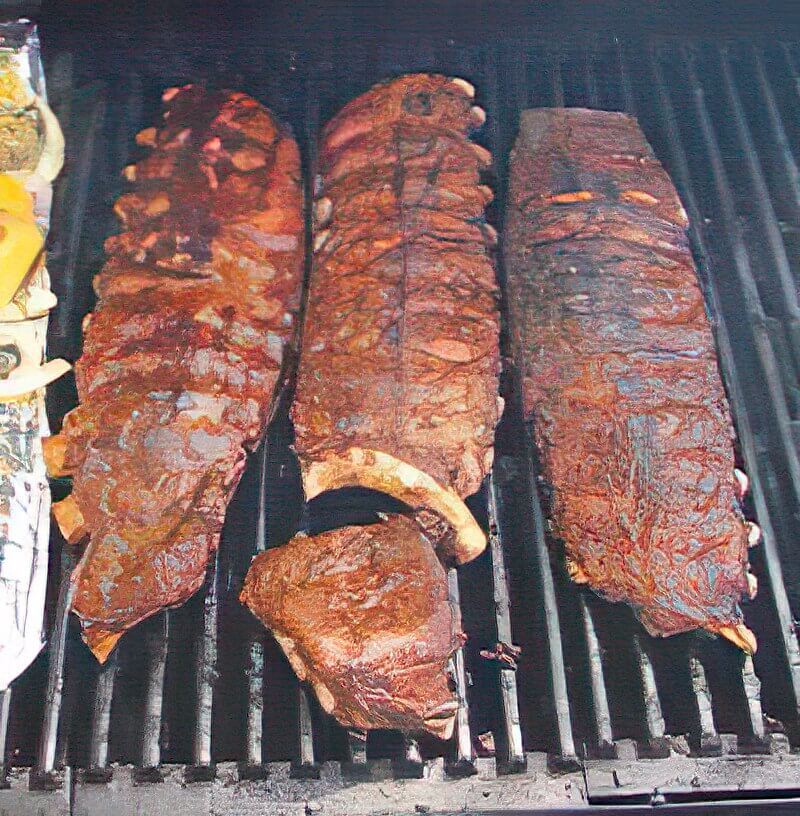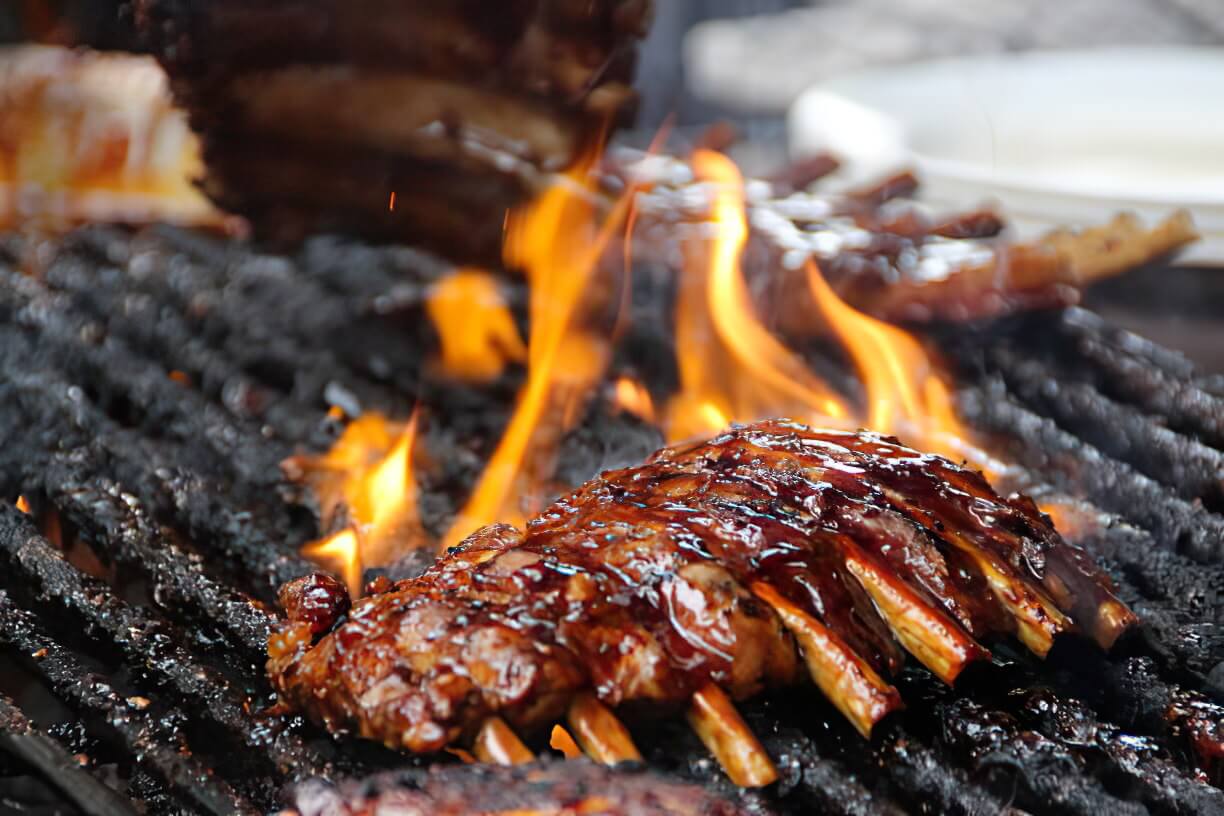Nothing quite says summer barbecue with BBQ ribs cooking! Grilled ribs are delicious and succulent. There are about as many different styles and flavors of barbecue ribs as there are letters in the alphabet! Maybe a lot more! In fact, it seems that just about every state in the US, especially the South, has their own unique way to prepare ribs and unique flavors to enhance them with.
While there is no way to cover all the possibilities of barbeque ribs recipes all in one place, here I’ll give you an overview of some of the different possibilities to consider both in the preparation of your ribs as well as the specific flavors to bring out the best in your barbecue ribs.
Wet BBQ Sauce Versus Dry-Rubbed Ribs
- Two big classic differences between different styles of ribs are wet BBQ sauces versus dry rubbed BBQ ribs. The wet sauces are what most of us usually think of as BBQ sauce, that dark, sticky and usually slightly sweet concoction which tastes delicious and gets all over your fingers. There are hundreds of versions of BBQ sauce recipes ranging from the sticky sweet to the fire hot to tart and tangy. Hundreds of these are pre-made and bottled and widely available at supermarkets, hot sauce shops and other specialty food stores. The specific flavors vary dramatically from one sauce to the next so you’ll have to experiment a bit to find the sauce that fits your taste. Other wet sauces for ribs can also include various ethnic sauces such as teriyaki.
- Although slightly less common, dry rubbed BBQ ribs is another way to flavor ribs which is absolutely delicious. In fact, I slightly prefer dry rubbed ribs. Something about the salt and spice really brings out the zing in your ribs and wakes up those taste buds! Basically, rather than a thick, sticky wet sauce, the ribs are marinated and rubbed in a spice mixture that coats the surface of the ribs. While I often still use liquids in the cooking process, particularly in basting the ribs as they barbecue, generally they are not as thick and sweet as wet BBQ sauces. I like using tangy liquids such as vinegars and lime juice to add a tangy zip to the flavors. For one idea for a tangy dry rubbed BBQ ribs recipe, see my BBQ Ribs Recipe.

Sweet Versus Tangy, Or Both!
BBQ ribs recipes generally vary from sticky sweet on one end of the spectrum to tangy and/or spicy on the other. Each has their own unique flavors and charms and if I had to choose between them I couldn’t! Variety is the spice of life, is it not? In fact, when cooking ribs, I often like to make two racks, one with a wet, sweet sauce and one with a tangy dry rub. However, both can include aspects of each flavor profile. For example, my “tangy and spicy” dry rub barbecue ribs include a fair amount of sugar and/or honey to balance the spice and acid with a bit of sweetness. Likewise, many wet BBQ sauces have a fair amount of acid tang, either from citrus and/or vinegar, to cut that heavy, rich sweetness. Again, which you prefer is a matter of personal preference. Those of us with a sweet tooth can cut out the acid and spice and focus on the sweet flavors (particularly brown sugar and honey) and those of us to love salty, tangy, spicy ribs can cut back on the sugar. Experiment and find the sauce you like best, but remember, your guests may vary in their preferences, so play it safe and make several versions of your delicious BBQ ribs to choose from!
Specific Regional Flavors
As I mentioned above, BBQ ribs don’t have to stick just to the traditional barbecue sauces. Ribs can be flavored with just about any spice rub or wet sauce. One great example is teriyaki sauce. Some of my favorites are the bottled teriyaki sauces from Soy Vay, including the Veri Veri Teriyaki (a traditional teriyaki recipe) and the Island Teriyaki (which includes a more honeyed and fruity flavor). These are great basting sauces to coat and glaze the surface of your ribs as they cook, building up a nice thick sweet glaze that is just delicious. I’ve had a lot of luck with other ethnic spice and sauce combinations such as Satay, Indian spice rubs, and Mexican Ranchero and Mole style sauces. Get creative! Don’t just stick to the tried-and-true sauces (although they are great), experiment a bit and find new BBQ ribs flavors to surprise your palate and your guests.
BBQ Ribs Cooking Styles: Pre-Boiled Versus Slow-Cooked Indirect Heat Barbecue Ribs
This is one of the biggest arguments in the world of BBQ ribs. Some people swear by their slow cooked barbecued ribs, cooked completely on their outdoor barbecue, and others insist that the ribs be boiled first, before finishing on the grill. The fact of the matter is that there is no right answer, both can be delicious! They just result in slightly different styles of ribs. Again, this is a matter of taste and the well armed grilling guru will have both techniques in their barbecue ribs armamentarium. In fact, ribs can even be cooked in the oven in your house in a pinch to good effect. No, you don’t get that nice smokey, caramelized flavor of real barbecued ribs, but for the winter months or if you don’t have a grill they still turn out pretty tasty.
One important point to remember about cooking ribs is that when they are done, they should be super-tender and practically falling off the bone. The novice rib chef may not realize this and will simply grill the ribs for a short time until they are cooked through. This will result in very tough, hard ribs! Ribs need to be slow cooked over a prolonged period of time to reach that “falling off the bone” consistency. This can be achieved with either slow, indirect heat on your barbecue or by pre-boiling.
- Pre-Boiled Ribs– Pre-boiled ribs are great because they allow the majority of the cooking to be done on the stovetop, only saving the final stages to be done on the barbecue. The advantage of this is two-fold: (1) The ribs do not dry out during a long cooking on a grill, and (2) it is easier to boil the ribs for a prolonged period of time than to keep the heat even on your charcoal grill with indirect heat for a prolonged cooking time. The general concept is that you boil the ribs for at least an hour (more depending on the type and size of your ribs) until the meat is starting to soften and reach the desired consistency. However, the boiling doesn’t do much to add good flavor to your ribs. One way to add extra flavor is to add beer to the boiling liquid. Other options to add unique flavors is to add whisky, bourbon, tequila or other liquors to the water. But to really instill them with flavor, you then let them cool, marinate them in your favorite BBQ sauce or spice rub, and then finish the cooking on the barbecue to brown the outside and develop a nice caramelized glaze. This results in juicy, tender ribs that are succulent and delicious.
- Slow-Cooked Barbecue Ribs – This technique of cooking BBQ ribs uses the indirect heat method of barbecue cooking which places the food away from the direct heat of the charcoal (or gas burner) so that it can slow-cook at a lower temperature for a prolonged period of time. This method is good for any larger cuts of meat that you want to cook thoroughly throughout. Because ribs take a long time to reach the point of “falling off the bone”, this method is absolutely necessary for cooking perfect BBQ ribs if you are not pre-boiling them. In addition to the instructions on how to use indirect heat on the link above, to keep your ribs juicy and succulent without drying out I recommend frequent basting during the cooking process. Because the ribs can take over an hour to cook with this method, you may need to add charcoal during the cooking process and you will need to baste many times to keep them from drying out.
About Cooking BBQ Ribs with Wet Sweet Sauces
One other tip if you are cooking with a wet sauce that is high in sugar content (like many bottled BBQ sauces and teriyaki sauces)…
If you are cooking completely on the barbecue, wait until later in the cooking process to add the sauce. If you add these sauces too early, the heat from the grill can burn the sugar. Initially, this just leads to caramelization which is a good thing, but with prolonged heat, this can quickly turn to a charred, burnt sugar crust on the surface of your ribs. Avoid this by only starting to add the sauce by basting partway through the cooking process. Allow enough time for the sauce to cook and thicken, turning to a nice dark caramelized brown on the surface of your ribs, but avoiding burning. Keep basting with the sauce during the final cooking time to build up a nice thick glaze of caramelized sauce on the surface. This is that great sticky coating that gets all over your fingers and you have to suck off!
Good luck honing your BBQ ribs skills and recipes! Be sure to check out my basic dry-rubbed barbecue ribs recipe!
Hi, I’m Adam and I’m a HUGE fan of Food and Cooking.
Do you enjoy grilling sessions with your family while staring at the beautiful fire pit flames?
Flame Gorilla is the site to learn how to have that perfect backyard experience.

